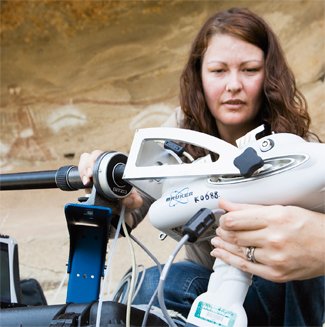X-ray gun reveals Aboriginal rock art

WHEN AN ARTEFACT must be destroyed in order to reveal the secrets it holds, you might say researchers are caught between a rock and a hard place.
Until now, pigment research carried out on Aboriginal rock art has meant removing a sample of the ancient paint for analysis in a laboratory. Although damaging to the artefact, this research can reveal information about social interaction, travel and trade during prehistoric eras of indigenous culture.
With this in mind, Jillian Huntley, an archaeologist at the University of New England in Armidale, NSW, is pioneering non-destructive methods for rock-art analysis. The new research, carried out in collaboration with the Australian Museum and sponsored by the Australian Geographic Society, uses an X-ray gun to analyse the chemical makeup of rock art, without destroying the sample.
“The major benefit of the method is that it’s completely non-destructive,” Jillian says. “It’s the first time we’ve been able to do this kind of research without going in with dental probes and scalpels.”
Aboriginal art determined by pigments
The X-ray gun, mounted on a boom arm with a 4m reach, sends an X-ray beam into the rock and measures the resulting fluorescent photon activity caused by moving electrons within the sample’s atoms. The type of energy produced by the photons varies depending on the chemicals that make up the sample. When measured, this energy can be used to identify elements in the rock, and, in turn, different types of ochre. The analysed artefact remains undisturbed.
“Eventually, we’ll be able to give the information generated by this investigation to cultural heritage managers, like the NSW National Parks and Wildlife Service, and the Aboriginal community. If they know what the pigments are made out of, they can decide on the best conservation methods for the rock art,” Jillian says.
Jillian knows of an Aboriginal elder who remembers seeing rock art at a particular site 30 or 40 years ago, which is no longer visible today. If the ray-gun method is successful, it could be used to identify whether ochre paint is present beneath layers of dust, mineral skins and modern layers, such as graffiti.
The ray-gun method is now being tested on rock-art sites across the Sydney Basin, on the NSW coast, on Aboriginal paintings Jillian estimates could be up to 1500 years old. When this research wraps up at the end of the year, Jillian will begin a second case study in the north-west of the Kimberley, WA.

RELATED STORIES

